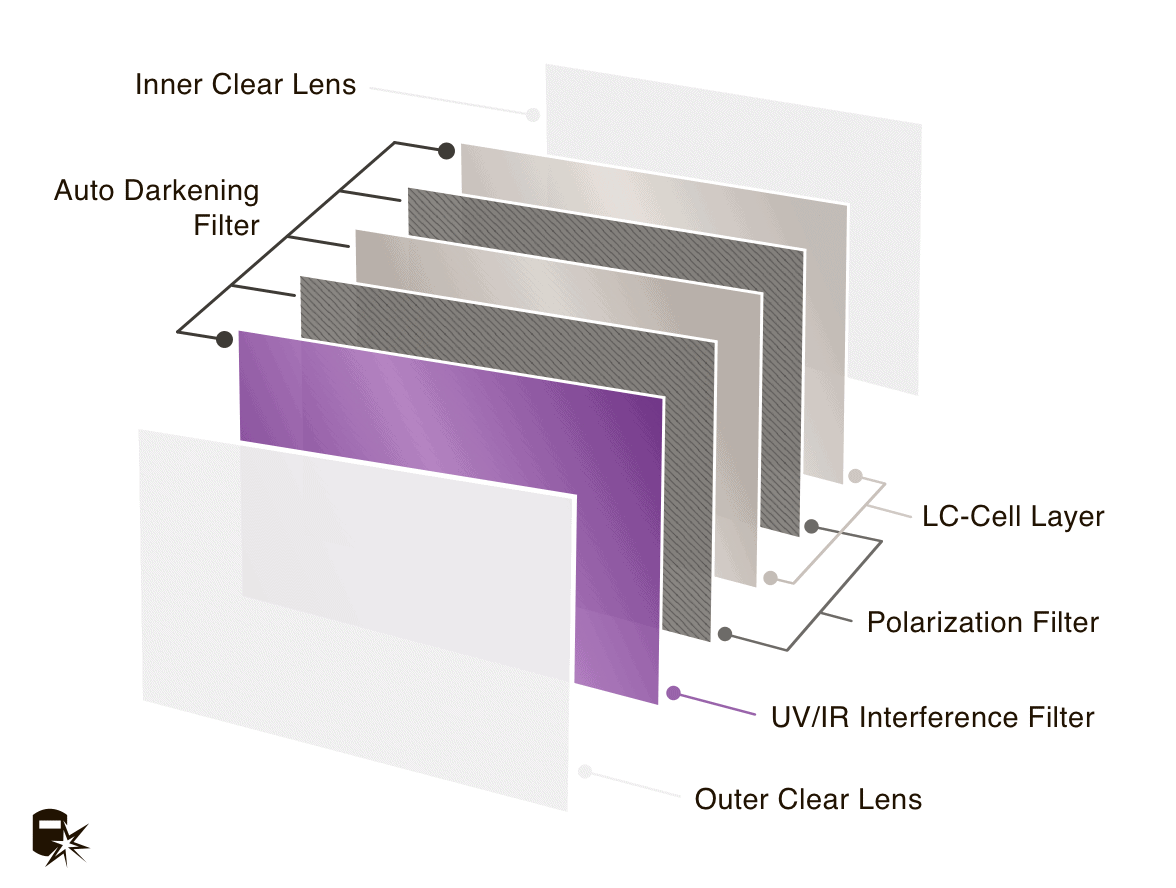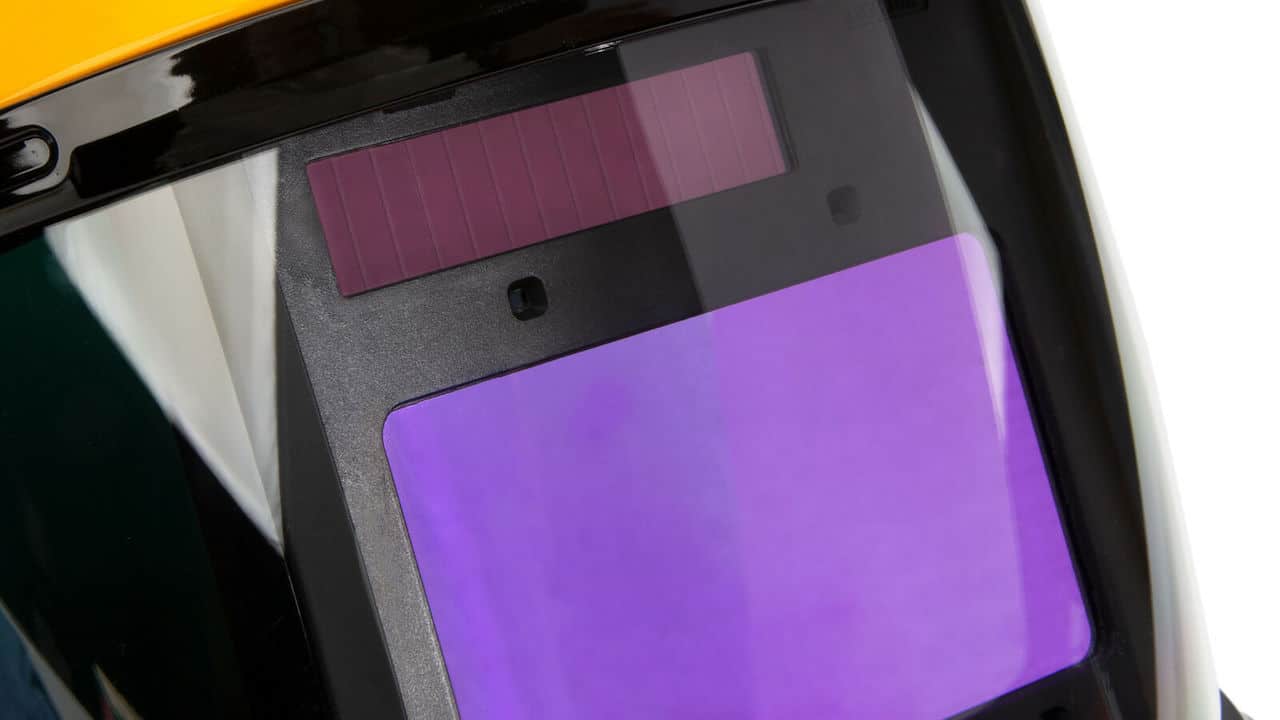Welding is a job where you must be aware of safety at all times. Beyond the possibility of burn injuries, your primary concern should be protecting your eyes from the intensity of arcs by wearing a proper welding helmet.
Your standard helmet requires you to lift and close it as you work, which can become tiresome and lead to problems if you forget to lower it at the needed time. An alternative to consider is an auto-darkening welding helmet.
You may have seen these but wondered how do auto-darkening welding helmets work? Not knowing how they work might make you write them off as a gimmick or fad, but once you learn more about them, you will see how beneficial they can be.
First, you need to understand the lens used in this type of helmet, its elements, and how those elements work to darken the mask.
Break Down of the Auto-Darkening Welding Lens

The welding lens in an auto-darkening welding helmet consists of a few different components. Each component is necessary to provide you complete protection against the Infrared/Ultraviolet light of the arc. Auto-darkening welding lenses are made up of three components:
- Polarization filter
- UV/IR interference filter
- LC-cell
Polarization Filter
The polarization filter appears multiple times in the layers of the lens. These filters darken the light. The movement of these filters changes how much light they dim. As you work the helmet, you will move these filters to give you the protection you need.
UV/IR Interference Filter
The UV/IR interference filter is on the outside of the lens. It helps reduce what gets into the lens by removing UV and IR rays. It works all the time. The auto-adjusting on the lens will not impact its operation.
The filter contains many layers itself. It includes silver, aluminum oxide, and glass substrate layers. The metal layers will reflect away the harmful light, while the different layers serve as additional filters to remove the light and prevent heat from entering the rest of the lens. Too much heat may harm the other layers and render them less effective.
LC-Cell Layer
LC or liquid crystal cells help defer light. Like the polarization filter, the LC-cell layers will reflect light depending on their positioning. Electrifying this layer will allow for additional manipulation of how it can move and change light coming into the lens, so this is why your welding helmet has an electrical component to it. You need that power or charge to activate the LC-cell layers.
Some Notes
You should note that not every lens will have the same design. It often depends on the manufacturer. The critical point of a lens and its components is the ability to defer and absorb light.
There also needs to be some way to manipulate the components to allow for the auto-changing of the protection.
When the auto-darkening welding helmet is off, it should allow you to see clearly with no or very minimal shading, even though some light restrictions will remain. Once you turn it on, it needs to respond quickly to darken and provide protection.
The components must do their jobs correctly to provide an effective helmet that works automatically. So, it doesn’t matter the exact components, but rather the important factor is that they work effectively.
How Does the Lens Work? Putting It Together
The components in the lens work together to produce the auto-darkening effect of the helmet. It starts with you striking an arc.
You will need to make sure your helmet is in the on position. Remember, the LC-cell layers require electricity to manipulate them into the right places.
Upon striking an arc, the arc sensors on the helmet will sense the flash and activate the changes in the polarization filters and the LC-cell layers. The LC-cell layers will twist to reflect more light. You will notice an immediate change in the darkening level, adjusting for the light sensitivity.
When you stop welding, the same arc sensors that pick up on the arc will notice the lack of light and make changes to lighten the lens.
The helmet does have a safety feature to ensure you have protection if the helmet fails. It comes from the default positioning of the polarizing filters in alignment. They are also at an angle that darkens the lens somewhat even before you activate the helmet. This gives you a fixed shade.
The polarizing filters work with the LC-cell filters at a specific angle to reflect light to darken the lens slightly in the off position.
As long as your helmet is on, you should not have to do anything to make the lens darken. You can preset the shade level based on your needs and preferences. The helmet will know how much to darken based on your settings.
Related read: Welding Helmet Lens Shade Guide
How Fast Do Auto-Darkening Welding Helmet Lenses Work?
Auto-darkening welding helmet lenses are only effective if they’re fast enough to activate before exposure. So how fast are auto-darkening welding helmets?
The good news is, auto-darkener tech is much faster than your hands in a manual flip-down scenario. But depending on the welding helmet you choose, the lens reaction time or the amount of time elapsed between arc sensing and activation can vary widely. Widely in terms of thousandths of a second, though.
Most auto-darkening technology activates within 1/25,000 and 1/10,000 of a second, according to product labels. At the slowest, that’s far less than one millisecond. For reference, one millisecond is about the time it takes for a camera to flash.
Related read: Welding Helmets with the Best Auto Darkening Technology
Switching speeds – which is how quickly the shade changes – also vary, but it will happen so fast, your eye won’t be able to tell the difference between one reaction time and another if the reaction times are less than 200 microseconds.
How to Tell If the Lens Is Not Working
You can normally tell if the sensors and electronics don’t work properly as you will see a very bright flash when you start to weld. It’s still safe to use because of the passive UV/IR filters in the lens.
The easiest way to test your lens to ensure the auto-dark function is working is to go outside and look at the sun. Your welding helmet should instantly react to protect you. If it doesn’t, you know you have an issue.
Wrapping Up
How do auto-darkening welding helmets work? It really is a fascinating answer as you begin to learn about the different parts of the lens and how they work together to provide you with effective protection against the welding arcs you work with throughout the day.
These helmets provide you with continuous protection. They reduce the need to flip your mask up and down.
Even if you aren’t currently welding, they can protect you as you move about your workspace and pass other welders or if you go outside into the bright sun.
Related read: How To Clean a Welding Helmet lens – 3 Tips
